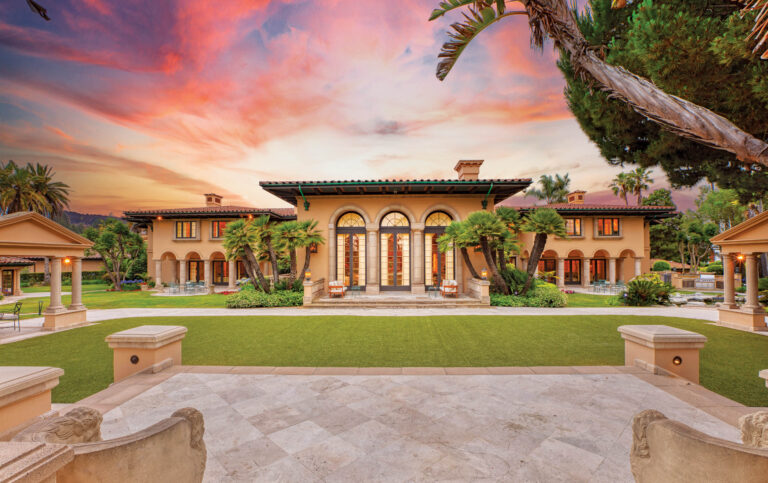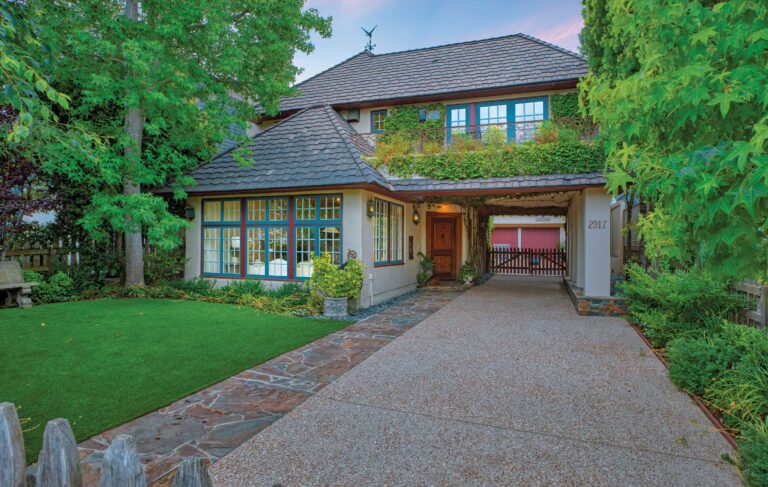Table of Contents
- “Marketecture”
- The digital revolution is old news
- Content is still king but the castle looks a lot different
- 3 tips on creating context for your audience and building local market share:
- Micro is the new macro
- Marketing is harder and easier at the same time.
- Brand is still all-important
- Time is everyone’s most valuable currency
- Market share’s ultimate virtue – Patience
- Staying Top of Mind
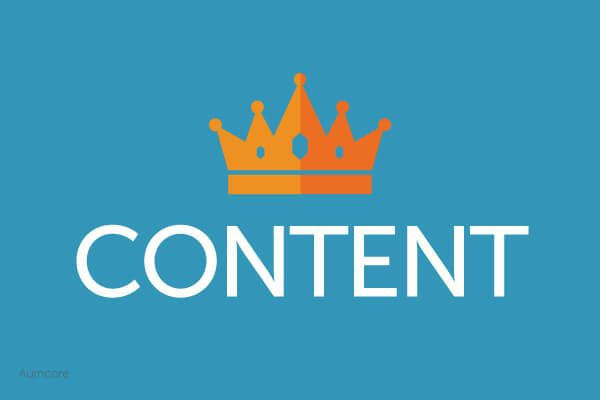
“Marketecture”
Yes, that’s a word. I made it up.
Actually, it’s a collection of thoughts I’ve had over the past several years on marketing while watching the local real estate professionals struggle to capture attention and engage in a digital world. Marketecture is what you happens when marketing and architecture collide to create a remarkable consumer experience with captivating content – one that is built to last. It’s talked about. It leaves an impression. It’s sought out versus waiting to be found. Many of the behemoth brands build market share this way.
And anyone can do it. In fact, this formula is much more tailored to the needs of smaller local brands.
I want to teach you a few methods you can use to start building market share within your communities with captivating content. You’ll learn creative ways to leverage captivating content that starts on a small scale, and grows exponentially.
But first, let’s take a close look at what marketecture looks like when applied correctly.
The digital revolution is old news
What’s new is what’s new, if you know what I mean. In February of 2004 it was Facebook, on March 21, 2006 it was Twitter, Instagram came in 2010. While the Internet changed our lives in the 1990s, social media changed our world in the 2000s. Next is artificial intelligence AI and self-driving cars.
It’s the Wild West all over again. To say these are interesting times diminishes the point – it’s a new paradigm. The world’s largest taxi company, UBER, owns no cars. The worlds largest media company, Facebook, creates no content. Largest real estate brand, Zillow, sells no real estate.
The new paradigm shift has changed the course of our lives. Everyone can access ANYTHING at anytime from almost anywhere. When Apple announced the iPhone in 2007, the world forever changed.
In the 1970s, the average person was exposed to 500 – 1,300 ads per day.
Today, it’s closer to 5,000!
Top put that into context, that’s 3 ads every minute, every day.
Sorta feels like someone’s targeting your every move, and showing up everywhere you are.
And they kind of are.
According to Statista, advertisers will spend $200 billion in 2018 on digital ads, 38% of the total global ad spend.
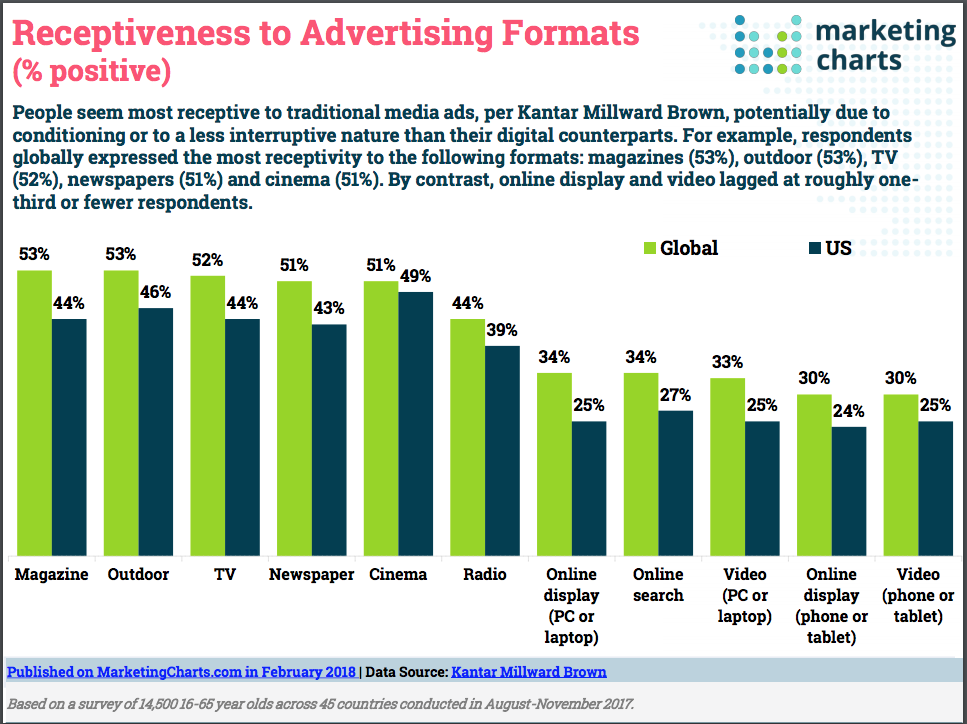
Despite this finding, people are still less receptive to online ads (34%) versus traditional media ads (58%).
That’s why it’s paramount to filter through the noise, and focus on reaching consumers where they spend their time, and who will most likely do business with you, not spray and pray.
According to the research, print magazines enjoy the highest user engagement and trust of any media channel.
They are the best way to build and grow a local brand.
Content is still king but the castle looks a lot different
Content used to be scarce, supplied in most part by the largest media companies of the day, and distributed on a finite number of mediums. In those days, marketing was all about the macro – get your brand and offering in front of as many eyeballs as you can, the more the better.
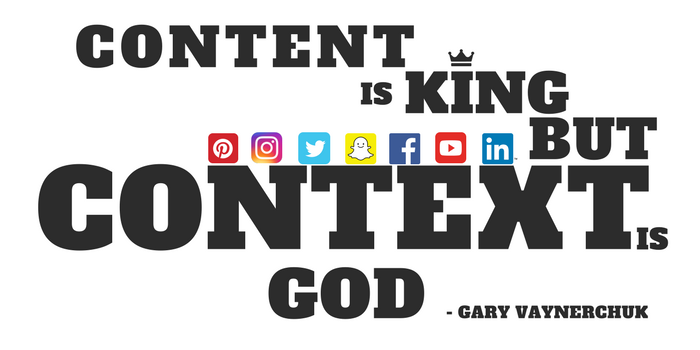
In fact, marketing was much more simple and straightforward then. “Spray and pray,” marketing was the norm and didn’t require a high level of strategic thinking, but you needed big dollars to play the game and win. The problem, back then as is today, is relevance.
If you were trying to target stamp collectors, how relevant was your big dollar advertisement in TIME magazine or the New York Times newspaper? Of the millions of circulation that you paid for, how many readers were stamp collectors? The challenge was the same with the other media channels – TV, radio, billboards, direct mail. You might have known how old they were, if they were male or female, and if they had a college education – but interested in stamps?
Today, content is abundant and you have an infinite number of distribution channels to deploy. The good news, relevance is achievable and you can market directly to a target audience as never before.
The truth of this has never been more true than it is today.
In fact, in January 1996, Bill Gates published an essay on Microsoft’s website entitled, “Content is King“, he said:
Content is where I expect much of the real money will be made on the Internet, just as it was in broadcasting…one of the exciting things about the Internet is that anyone with a PC and a modem can publish whatever content they can create.”
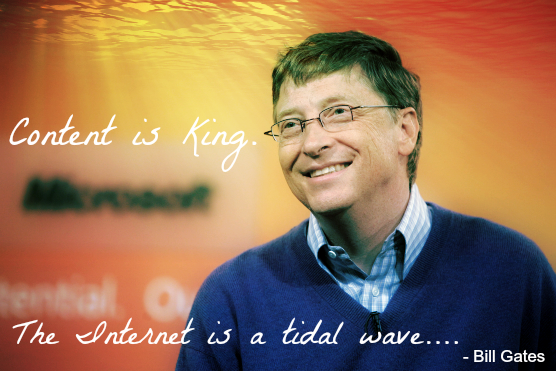
Eighteen years ago Bill Gates predicted that building market share is directly linked to creating and distributing “extremely up-to-date information” in a way where people want to engage, share, comment, hashtag, and recreate new content across all platforms.
Captivating content is “predicated upon context”, as Gary Vaynerchuk has often been quoted as saying, “Content is King, but Context is God.” In order to be successful with content, you have to have the tools at your disposal to execute in a contextual way.
The following three tips from Gary Vaynerchuk apply directly to real estate professionals more than ever.
- Respect the reason people are using the platform
- Don’t interrupt your audience’s experience with ads that don’t provide value
- Be consistent with your brand messaging – whether you’re tweeting, commenting, or hashtagging – make sure it’s attached to your core brand goals.
I highly recommend reading his full article, read Gary’s entire article here.

Micro is the new macro
According to eMarketer, global ad spending is predicted to reach $583.91 billion in 2017, with digital ads making up about 38% of that total. Unfortunately, most of those ad dollars will go to waste – never reaching their intended and most relevant audience, and thus offering no return on investment.
The challenge that every marketer faces is how to best engage and delight consumers so they eventually become customers and brand enthusiasts. We may be living in a digital world, but the landscape is overly crowded with messaging – that’s why is critical to filter out the “noise” and strategically target consumers who are most likely to do business with you.
I highly recommend Seth Godin’s seminal book “Tribes: We Need You to Lead Us” – which talks about how the Internet has ended mass marketing and how founded on shared ideas and values, tribes give ordinary people the power to lead and make big change.
Marketing is harder and easier at the same time.
Wait, what?
Despite what I said earlier, it seems old times never change.
“Spray and pray” marketing is more alive and kicking than ever before. Banner ads anyone? In some ways, online marketing (PPC, SEM, SEO, Facebook, etc.) has become a modern version of direct mail. With an endless supply of content and infinite distribution channels, we have created the ultimate SPAM paradise.

Marketing is easier today in the sense that we can leverage audience filters to target and retarget prospects, but there’s way too much messaging and way less attention span out there today, so no one is really paying attention.
Consumers suffer from content fatigue – in fact you only have about eight seconds to engage them online before they leave your website, landing page, video, or social post.
Need a marketing expert? Bad news, they don’t really exist. It seems everyone claims to be a marketing expert these days.
It’s about them – they want to sell you the next great tech tool and promise the world. What you need is the knowledge on how to create value for your consumer and reverse engineer from there. And whether you like it or not, you need to start thinking and acting more like a media company – content marketing is now the rule.
With attention spans at an all-time low, the age-old battle about which marketing method is best, print or digital, is still relevant.
The truth is, both methods can be useful.
The key to knowing where to spend your marketing budget is in understanding your target audience, and which platform reaches them best.
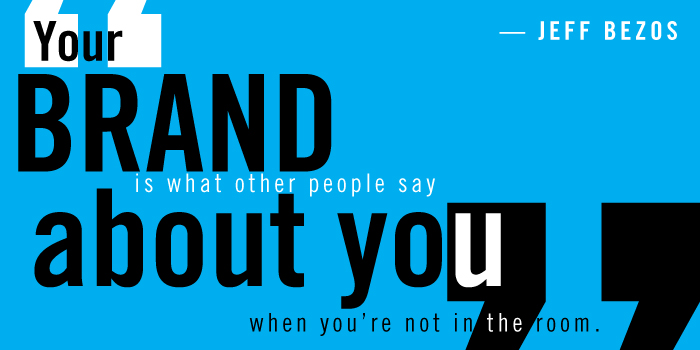
Brand is still all-important
Building a brand is old school, but it’s actually never been more imperative, plus it’s the path to more leads.
To create a successful brand today and build local market share, you need to focus acutely on creating relevant content that will magnetize a specific audience who will eventually become customers. More importantly, you need to trade value for their time and engagement.
Time is everyone’s most valuable currency
Despite what the marketing pundits will say, building a successful brand is the best way to create and sustain a business that is built to last. Your brand has life – it’s alive! It’s reputation precedes you in the market – it’s what consumers think of when their ready to make a purchase decision. Most important of all, brands are about trust. And trust is why consumers buy.
Leverage is about repetition and relevance. Your marketing and messaging needs to be consistent and highly relevant to the audience your targeting.
Despite the fact that “44% of buyers find their homes online, real estate agents still account for 33% of the home discovery process.”
That’s a third of all transactions going to you, the realtor.
Oh, and of the 44% who find their place online, most call an agent next.
This strong indicates that you need to be marketing yourself and building your brand at all times.
After all, Jeff Bezos, Founder and CEO of Amazon said it best, “Your brand is what people think about when you’re not in the room.”
If you’re not showing up on a consistent basis and leveraging your brand, your consumers will find an agent that is, and build market share with that agent.
Market share’s ultimate virtue – Patience
Our digital world has created a transaction economy and transactional consumer mindset. According to a report by the U.S. Commerce Department, online sales reached $394.86 billion last year, which comprised nearly 42% of the growth in the U.S. retail market in 2016. For comparison, total retail sales were $3.5 trillion in 2019 – e-commerce sales now represent 16% of total retail sales over the past 10 years.
The danger lies in believing our marketing needs to be transactional too. There’s no such thing as quick and easy – it’s more like slow and steady. The most successful marketing and brand building has always been more of a marathon than a sprint. What we lack today is the patience to run that race.
It has been said that “we love to buy stuff, but hate to be sold to,” yet many marketers, real estate agents, and sales reps continue to hard sell potential customers.
Their hope is that the customer will be ready to buy what they have to offer after seeing their ad, visiting their website, reading their blog, and opening their email. It’s easy to fall into that trap, simply because it’s the easiest.
Instead, building a tribe of loyal fans and earning market share through content marketing takes time.
Neil Patel, said this about patience, “With content marketing you really have to be patient. It doesn’t just open the flood gate and gives you all at once — it takes time. But if you’re persistent, you’ll see good scores, metrics will eventually start improving, and all your content marketing efforts will finally start to pay off.”
From PR to local print magazines to SEO, social media ads, video and blogging the goal should be to provide value at every step along the customer journey in the hope that what you give them they find interesting and valuable.
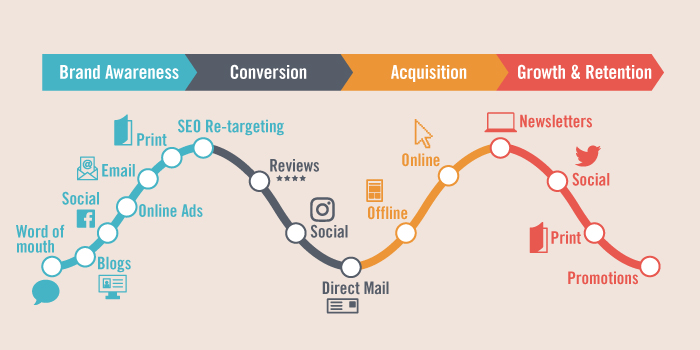
Staying Top of Mind
If you provide a remarkable customer experience from A to Z, your customer will inevitably grow an affinity to your brand which may lead them to buy what you’re selling.
Your job is to be the purveyor of accurate and valuable information, not to convince people to buy.
They’ll make the decision.
You just have to make that process as easy and stress-free as possible.
In my mind, building a legacy brand in a micro-market is still paramount to everything else – it’s a scalable architecture and creates a hyper-local engagement funnel, which then translates into “mind share” and ultimately, “market share.”
The market share winners today are focused entirely on the consumer experience and creating value first, playing the long game, building an engaged audience, and over-indexing on delivering captivating content.
I call it marketecture.
